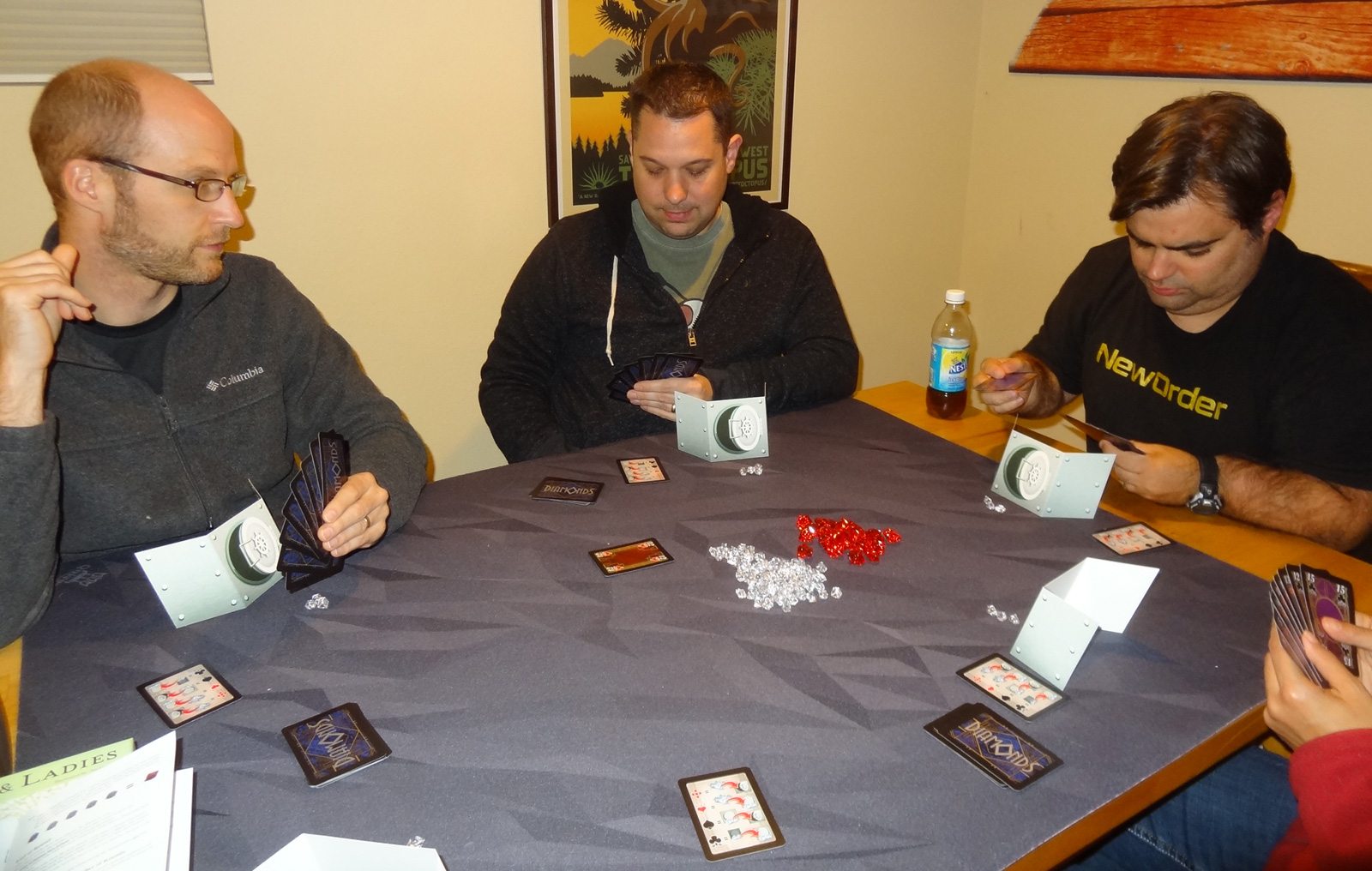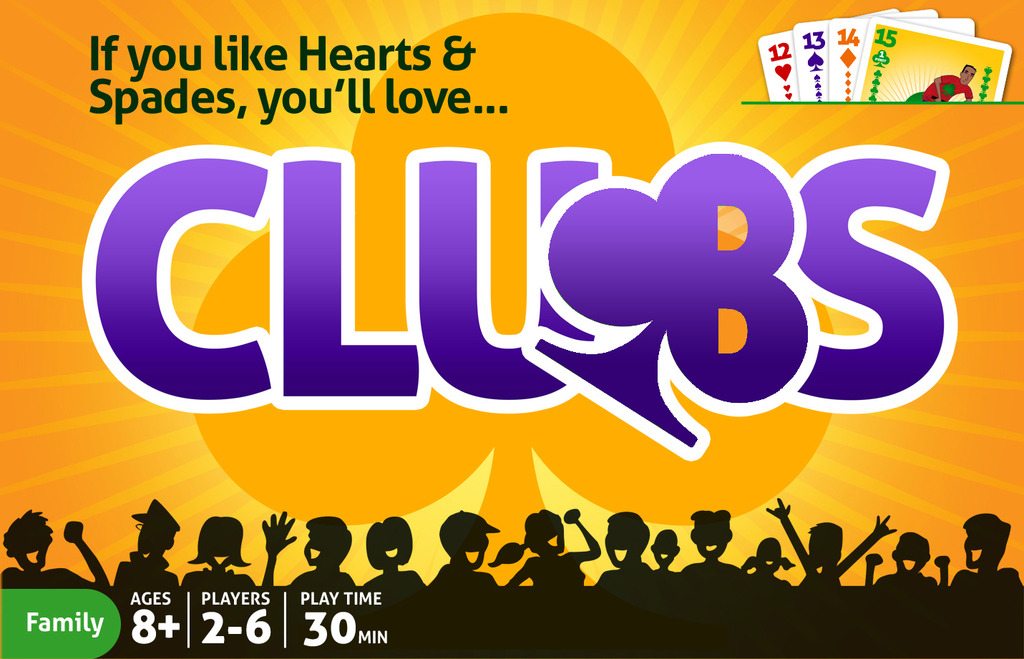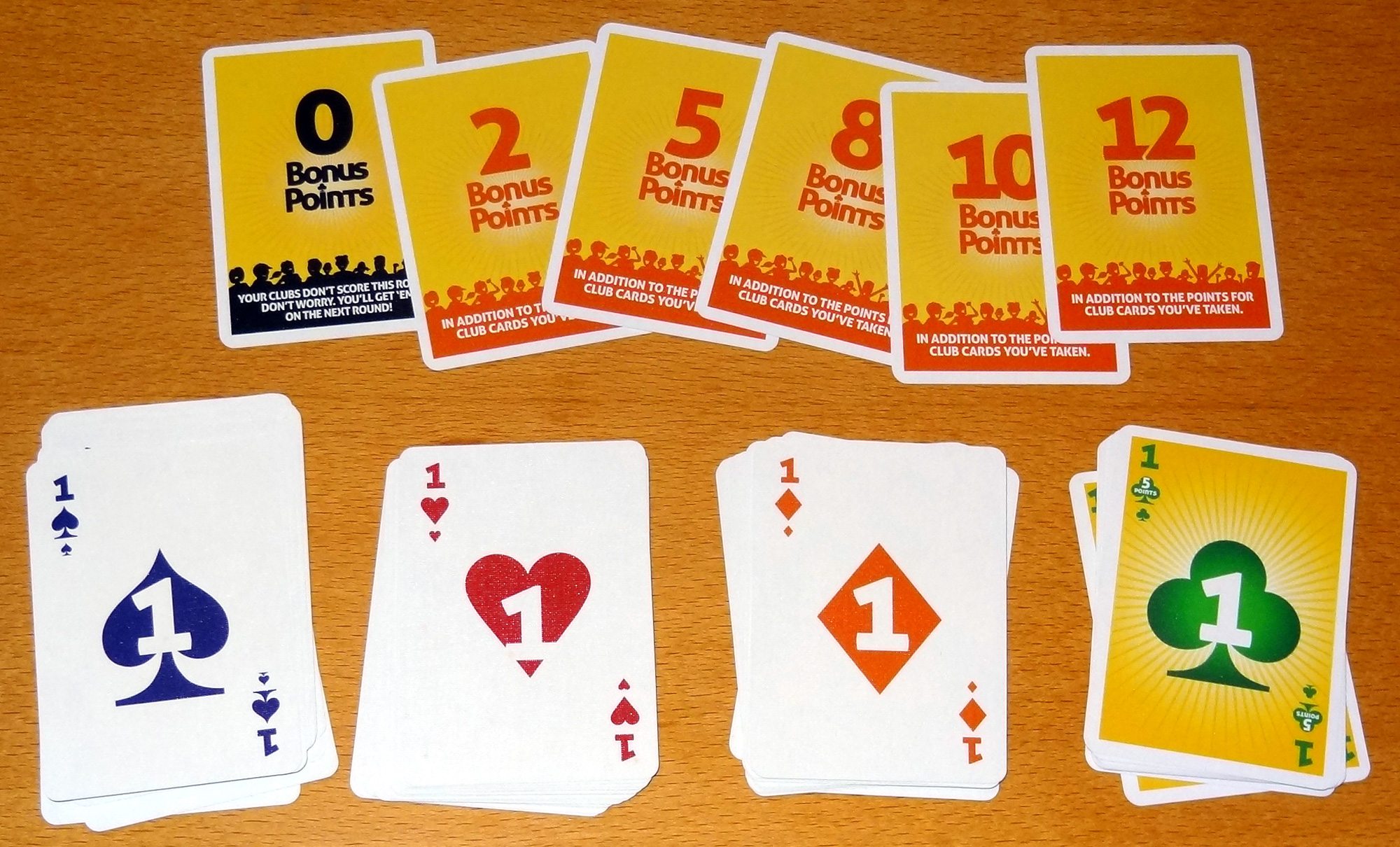Trick-taking games have been around for a long time, but they’re still quite popular among card players, and new variations continue to appear. You’ve played Hearts and Spades? Let me introduce you to Clubs and Diamonds.
At a glance: Both Clubs and Diamonds are for 2 to 6 players, ages 8 and up, and take about half an hour to play. The age rating is about right, though there’s no reason you couldn’t try it with somewhat younger players who are used to card games. Diamonds has a little more direct attack in it. Clubs retails for $13.99 and Diamonds retails for $24.95.
We’ll start with Clubs, designed by Dominic Crapuchettes and published last year by North Star Games.
Components
- 60 cards (15 cards each in 4 suits)
- 6 Bonus cards
Clubs is a pretty compact game: in fact, it could pretty much fit in a simple tuckbox, but it comes in a slightly larger box with a plastic insert. The cards are quite nice, with a linen finish and very easy to shuffle. The design, as you can see in the photos, has a large suit symbol with the number in it in the center of each card, and then the number and a row of symbols down the sides of the cards. The clubs also have a number of bonus points shown on them, and the 15 of each suit has an illustration.

How to play
The goal of the game is to get the most points by winning tricks that include clubs and getting rid of your cards quickly.
You’ll use a set of bonus cards according to the number of players—basically one bonus card per player, starting with the 0 card. These are set in the center of the table. 10 cards are dealt to each player, and the person to the left of dealer will be first to lead.
The basic play is like Hearts or Spades, but instead of playing a single card, players play meld-types: x-of-a-kind, or a run of cards in sequence. The leader plays a meld-type of their choice, and then all other players must play the same meld-type or pass. A player wins the trick either by playing a meld-type that includes a 15, or when all other players pass consecutively after them. The winner takes the trick and sets all those cards aside for scoring, and then becomes the next leader.
When a player uses up all of their cards, they “go out” and then take the highest valued Bonus card available. The last player to go out (or left with cards in their hand) takes the 0 Bonus card.
At the end of the round, when all Bonus cards are claimed, everyone scores points for clubs they’ve taken (according to the values shown on the cards), plus their Bonus points. The player with the 0 Bonus card, however, doesn’t score anything at all.
Continue playing rounds (changing dealer each time) until somebody ends with 50 or more points, and then highest score wins.
Clubs comes with several variants: two-player rules, 15s are wild, and partnership rules. There’s also a variant called Crazy Clubs, which adds two new rules:
- 15s can be beaten: if you play a meld-type that has one more card than the meld-type that includes the 15, then you beat it and the trick continues. So, for example, a run of 14-15 can be beaten by a 3-4-5 because it’s a longer run.
- The meld-type you play must match the meld-type led and have either a higher card than the highest card from the previously played meld-type, or a greater number of cards.
These rules do change up the game a bit, because you have to be careful when to use your 15s or how to arrange your cards into meld-types.
The Verdict
The use of meld-types in Clubs definitely sets it apart from most trick-taking games I’ve played, which tend to use single cards instead. It makes it a little more like rummy: once you’ve played a meld-type then you can’t decide later to rearrange your cards into something else. The scoring is interesting: the higher-numbered clubs are worth fewer points. It’s easy to win with a 15, but it’s only worth a point. But if you have a low club, you have to be more careful about playing it so that you don’t award an opponent a lot of points.
The bonus cards are an extra incentive to use up your cards—not just because you want more bonus points, but because the last player to go out doesn’t even get any points for their clubs. It does mean, though, that scores can swing wildly from round to round, particularly in a 6-player game, where the first player to go out gets 12 points not even counting any clubs they’ve taken.
I do recommend the Crazy Clubs variant because of the way that 15s can be beaten by using more cards. It means there’s a little more strategy and bluffing involved as you try to figure out whether it’s worth playing your low run of three cards now, or saving it for a later trick.
While the game can be played with two players (and the variant rules aren’t bad), I do think that trick-taking games are more interesting when you have at least three players, and it’s nice that it accommodates up to six players. I think Clubs can be slightly trickier to learn than a traditional trick-taking game because of the meld-types, but even that isn’t terribly hard to overcome.
 And now for Diamonds, designed by Mike Fitzgerald and published this year by Stronghold Games. It uses trick-taking as a means to collect diamond tokens, which determine your score at the end of the game.
And now for Diamonds, designed by Mike Fitzgerald and published this year by Stronghold Games. It uses trick-taking as a means to collect diamond tokens, which determine your score at the end of the game.
Components
- 60 cards (15 cards in 4 suits)
- 110 small plastic diamonds
- 25 large plastic diamonds
- 6 Vault screens
- 6 player aid cards
The cards are a nice quality, with a linen finish and an Art Deco look. The suit icons are kind of fancy, which can make them a little harder to read, but the card backgrounds have different colors and shapes to help distinguish them. Interestingly, the cards don’t have icons on the body of the card, just in the corners with the numbers. There are the four standard suits—diamonds, hearts, spades, clubs—but each suit goes from 1 to 15 instead of the regular 2 through Ace.

The “diamonds” are small plastic gems—small colorless gems and large red gems, which are worth 1 and 5, respectively. The “vaults” are cardstock tri-fold screens with a vault door image on the front. Your gems can either be in your vault (behind the screen) or in your showroom (in front of the screen).

The player aid cards show each suit’s power. The iconography is fine once you get used to it, but you’ll have to refer to the rulebook the first time you play to see what they mean. The only thing I don’t like about the reference cards is that they have the same backs as the rest of the deck, which means if you’re not paying attention you could shuffle them in.
How to play
The goal of the game is to get the most points in a certain number of rounds by collecting diamonds.
Each player gets a Vault and puts 3 small diamonds in their showroom (in front of the screen). For each round, everyone gets 10 cards and the rest are set aside. The dealer gets to look at her hand of cards, and then decide whether to pass 1, 2, or 3 cards to the left. All other players will pass the same number of cards to the left.
The basic play is much like Hearts or Spades, but there are special “suit actions” that come into play:
- Diamonds: Put a diamond from the supply into your vault.
- Hearts: Put a diamond from the supply into your showroom.
- Spades: Put a diamond from your showroom into your vault.
- Clubs: Put a diamond from another player’s showroom into your showroom.
One player (starting with the player to the dealer’s left) will “lead” the trick by playing any card to the center of the table. All other players must follow suit (play the same suit as the lead) if possible. However, if you have no cards of the lead suit, you may play any card from your hand—and then you immediately get a suit action of the card you played. Once each player has played a card, whoever played the highest card in the lead suit wins the trick, takes all the played cards and sets them in a pile, and gets a suit action of the lead suit.
Once the round is over—after everyone has played all 10 of their cards—you examine the all the cards won in tricks. The player who has the highest number of cards in each suit gets an additional suit action. In case of a tie, nobody gets the action. Also, if you took no tricks at all, you get two Diamond suit actions.

The game lasts a number of rounds based on the number of players. At the end of the game, all of your diamonds in your vault count for two points each, and the diamonds in your showroom count one point each. Highest score wins, with ties going to the most diamonds in the vault.
There are a few variants included: the 2-player game mixes things up a bit, or you can play 4 or 6 players with partners. Finally, “Perfect Diamonds” adjusts the deck so that all of the cards are in play in each round, rather than some cards being unknown.
The Verdict
Diamonds was released at Gen Con this year, and it made a pretty big splash. I heard a lot of buzz about it, which is interesting for a game that doesn’t involve worker placement or zombies or real-time cooperation. I didn’t get a chance to play it until more recently, though, and it’s a solid trick-taking game that offers some nice changes from more traditional games like Hearts and Spades.
The suit actions and the diamonds make for an interesting dynamic. It’s not as important to win tricks as it is to use your suit actions wisely so you can get diamonds into your vault. In fact, since you get two diamond actions when you don’t win any tricks, sometimes that’s a really great strategy. Diamonds in your vault are safe, but getting a lot into your showroom tends to make you a target for other players’ club action.
Because of this, deciding which cards to pass can be pretty important. You don’t just want to get rid of low cards; you want to choose cards so that you’ll be able to break suit and play other suits for their actions. I discovered this the hard way, passing off some low diamonds and then realizing that I wouldn’t be able to get any diamond actions that round. In another round, I ended up with a lot of spades; however, because I ran out of diamonds in my showroom, I couldn’t use the spade action (which puts diamonds from my showroom into my vault).
If you’re playing with fewer than 6 players, there are always unused cards (except in the Perfect Diamonds variant), which can be interesting, too. It means that you never know what the highest card in any given suit is. Maybe a 13 could guarantee you the win—do you lead with it in the hopes that nobody has the 14 or 15? It adds an element of the unknown that I liked, but the Perfect Diamonds variant would be better for people who want a better handle on the odds.
I think Diamonds is a nice, easy-to-learn trick-taking game, and it’s easy to see why it was popular. It plays quickly and gives you a nice range of choices as you play. It won’t replace the heavier games I tend to play more often, but I think it’ll be great for kicking off a game night or in between longer games. As with Clubs, I think it’s nice that it accommodates a wide number of players, though I’d still prefer at least 3.
Overall, both Clubs and Diamonds are interesting new twists on the old trick-taking genre, and if you enjoy Hearts or Spades it’s worth your while to check them out. Clubs can be a little trickier to learn, but it’s also slightly more portable (and takes up less table space) since it doesn’t have the diamonds and vaults. Diamonds is probably a better entry-level game, but still has good depth of strategy—and bling, of course. Both games would be a nice addition to the casual games section of your collection.
Disclosure: GeekDad received review copies of both games.






